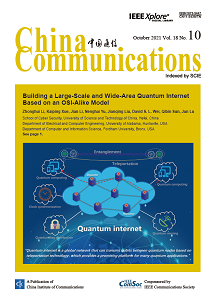基于随机森林和 60 GHz 毫米波高精度定位的高精度 NLOS 识别
IF 3.1
3区 计算机科学
Q2 TELECOMMUNICATIONS
引用次数: 0
摘要
60 GHz 毫米波(mmWave)系统具有极高的时间分辨率和多径分量(MPC)分离能力,在实现高精度室内定位方面潜力巨大。然而,测距数据经常受到非视距(NLOS)传输的污染。首先,评估了 60GHz 毫米波信号在 LOS 和 NLOS 条件下的六个特征。然后,使用随机森林(RF)算法构建的分类器来识别视距(LOS)或非视距(NLOS)信道。该识别机制具有出色的泛化性能,分类准确率超过 97%。最后,基于识别结果,提出了一种残差加权最小二乘法定位方法。该方法充分利用了包括 NLOS 信道在内的所有测距信息,避免了因 LOS 链路不足而导致的定位失败。与传统的最小二乘法相比,所提算法的定位误差减少了 49%。本文章由计算机程序翻译,如有差异,请以英文原文为准。
High-accuracy NLOS identification based on random forest and high-precision positioning on 60 GHz millimeter wave
60 GHz millimeter wave (mmWave) system provides extremely high time resolution and multipath components (MPC) separation and has great potential to achieve high precision in the indoor positioning. However, the ranging data is often contaminated by non-line-of-sight (NLOS) transmission. First, six features of 60GHz mmWave signal under LOS and NLOS conditions are evaluated. Next, a classifier constructed by random forest (RF) algorithm is used to identify line-of-sight (LOS) or NLOS channel. The identification mechanism has excellent generalization performance and the classification accuracy is over 97%. Finally, based on the identification results, a residual weighted least squares positioning method is proposed. All ranging information including that under NLOS channels is fully utilized, positioning failure caused by insufficient LOS links can be avoided. Compared with the conventional least squares approach, the positioning error of the proposed algorithm is reduced by 49%.
求助全文
通过发布文献求助,成功后即可免费获取论文全文。
去求助
来源期刊

China Communications
工程技术-电信学
CiteScore
8.00
自引率
12.20%
发文量
2868
审稿时长
8.6 months
期刊介绍:
China Communications (ISSN 1673-5447) is an English-language monthly journal cosponsored by the China Institute of Communications (CIC) and IEEE Communications Society (IEEE ComSoc). It is aimed at readers in industry, universities, research and development organizations, and government agencies in the field of Information and Communications Technologies (ICTs) worldwide.
The journal's main objective is to promote academic exchange in the ICTs sector and publish high-quality papers to contribute to the global ICTs industry. It provides instant access to the latest articles and papers, presenting leading-edge research achievements, tutorial overviews, and descriptions of significant practical applications of technology.
China Communications has been indexed in SCIE (Science Citation Index-Expanded) since January 2007. Additionally, all articles have been available in the IEEE Xplore digital library since January 2013.
 求助内容:
求助内容: 应助结果提醒方式:
应助结果提醒方式:


